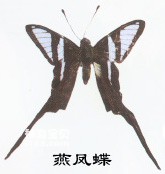Alias of swallowtail butterfly: swallowtail swallowtail butterfly, pink and white swallowtail butterfly, rare butterfly, dragonfly butterfly, white-banded swallowtail butterfly, white-banded swallowtail butterfly.
Adult: wingspan 40-45 mm. Antennae black. The back of the body is black, the head is broad, and the abdomen is short. The ventral surface of the body is pale. The wings are black; there is a gray-white band in the middle and inner area of the forewing, the end half is transparent, and the veins are very clear. The hind wings are narrow and long, and the tail process is extremely long, which is unique among swallowtail butterflies. There is a gray-white band diagonally from the middle of the front edge to the tail process, but it ends before the tail process, and is connected with a light gray-white band emanating from the middle of the inner edge. Converging; outer edge wavy, edged with white to end of caudal process. There are long white hairs in the anal fold of the male butterfly's hind wings. The front and rear wing bases on the back of the wings are grayish white, and the rest are similar to the front.

Host: Illigera platyandra, I. cordata and other plants of the Hernandiaceae family.
Biology: The adult forewings vibrate violently, and the hind wings extend horizontally to the rear. They usually fly along forest trails and places not high above the ground, often rushing forward or retreating. They are greedy water suckers, and they look like dragonflies when flying and swaying on the water, so some people call them dragonfly butterflies. The strange thing is that fluid often ejaculates rhythmically from the end of the abdomen. Both sexes love to visit flowers to suck nectar. Before sucking nectar, their wings keep vibrating, and their tails also swing. When they stop on flowers, their abdomen is raised high. Usually it flies very fast and is difficult to catch. Eggs are laid singly on the underside of young leaves of the host plant. The larvae live on the underside of leaves. Young larvae have the habit of opening a round hole in the middle and side of the leaf to feed. Mature larvae pupate on the undersides of leaves of other plants near the host plant. This species is a subtropical and tropical species.
Distribution: Sichuan, Yunnan, Hainan, Guangdong, Guangxi, Hong Kong; India, Bhutan, Myanmar, Thailand, Cambodia, Vietnam, Indonesia, Malaysia, and the Philippines. This species is listed as a protected species in Malaysia.
animal tags:
We created this article in conjunction with AI technology, then made sure it was fact-checked and edited by a Animals Top editor.